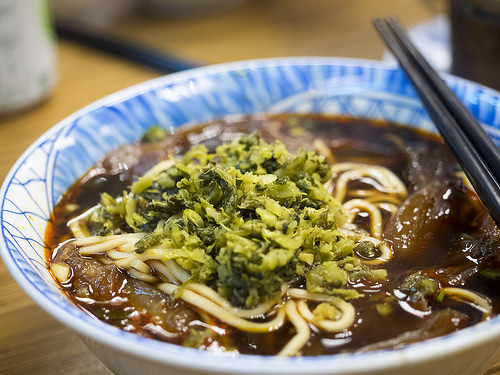There is a lot to explore in Taiwan – and its food is a good place to start. Aside from local flavours and character, Taiwanese cuisine over the years has incorporated influences from both mainland China and Japan. Xiaochi, or the Taiwanese equivalent of tapas, are an interesting and important part of Taiwanese culinary culture and a major tourist attraction as well. The best places to find and savour different kinds of xiaochi are the various night markets and food streets in Taiwan.Taipei, the country’s capital, has more than fifteen night markets that cater to hungry residents and tourists alike. These are the five foods that you absolutely must try while living in Taiwan.
Beef Noodle Soup: This is a dish of Chinese origin that has taken on its own identity in Taiwan and is one of the most popular dishes in the country, whether served at a night market or an upscale restaurant. The soup is made from braised beef, beef broth, vegetables, and of course noodles. The beef is usually red braised, or cooked in soy sauce and broth for hours at a time or even overnight. Some vendors slow cook the soup with marrow and fat, which tends to give it a slightly sweeter taste. However, the soup can sometimes be spicy and there are a number of variations available, including one in which pieces of tomato are simmered in the soy broth, which is especially popular in Taiwan.
Cho Dofu: You either love it or you hate it! Also known as stinky tofu, locals love this fermented tofu that has a really strong fragrance – it’s been compared to rotting garbage! But the Taiwanese believe that the smellier the tofu is, the tastier it is. Tofu is usually marinated in brine that can contain anything from fermented milk to vegetables and meat, and the recipe for the brine is usually a very closely guarded secret. The fermentation process can take up to a week, and the finished tofu is usually served deep fried, garnished with pickled cabbage and soy sauce. There is a large range of stinky tofu enjoyed in Taiwan, and this includes the spicy, barbecued, and soft varieties. Spicy stinky tofu is also being increasingly added to hot pots to give them flavour and depth.
Sun cake: Originating from the city of Taichung, this Taiwanese favourite consists of layered, baked phyllo pastry, and has a centre of condensed maltose and sometimes honey, made into the shape of a sun. The stickiness of the filling is perfectly balanced by the flakiness of the pastry, and these cakes are a popular tea time treat. They are also a great souvenir to take when you are travelling back home or when you have visitors who want to take back something quintessentially Taiwanese.
Iron eggs: Considered a great delicacy, these chicken, quail, or pigeon eggs are red cooked, or cooked in a soy sauce marinade, and then dried many times until the white of the egg becomes tough and the yolk becomes chewy. These eggs were first made in Damshui, a town north of Taipei, and are said to have been made by Huang Zhangnian, a restaurateur who, to keep cooked eggs warm, continually cooked them in soy sauce broth. The result was unexpectedly popular not only in Taiwan but, in recent times, also in countries in Africa and the Middle East. Iron eggs can also be cooked in tea, and they should be distinguished from black eggs, since they cannot be made from duck eggs.
Ba-wan: One of the most popular items at a night market, and perhaps Taiwan’s national comfort food, ba-wan is a translucent dumpling, stuffed with either vegetables or meat and usually served with a large helping of a sweet and sour gravy. The usual filling is a combination of pork, shiitake mushrooms, and bamboo shoots. The dough for the dumpling, which turns translucent on cooking, is made from sweet potato starch, rice flour and corn starch and these ingredients combine to give ba-wan its gelatinous look and chewy texture. While ba-wan is usually served steamed, it can also be served deep or shallow fried.
Can we improve this article? Something wrong? Let us know in the comments.

